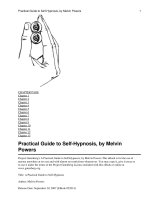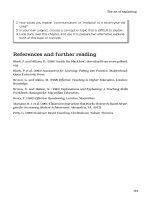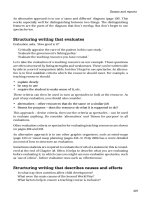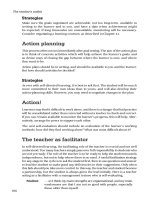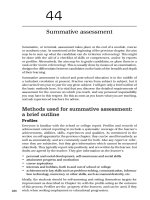Echocardiography A Practical Guide to Reporting - part 1 pot
Bạn đang xem bản rút gọn của tài liệu. Xem và tải ngay bản đầy đủ của tài liệu tại đây (611.31 KB, 16 trang )
Echocardiography: A Practical Guide for Reporting
6
Figure 2.1 Arterial territories of the heart. The motion of the endocardium within
each arterial territory should be described (Table 2.1). A 17-segment model has been
proposed for myocardial contrast studies or when comparing two different imaging
modalities. This has not superseded the 16-segment model for routine use
(Reproduced from Segar DS et al. J Am Coll Cardiol 1992; 19: 1197–202 with
permission)
ch02 4/5/07 1:32 pm Page 6
3. Global function
Some measure of global function should be given. Any or all of the follow-
ing may be used, depending on the preferred practice of the individual
laboratory.
LV cavity volumes and ejection fraction
• With experience, the ejection fraction can be estimated by eye.
1
A
value to the nearest 5% or a range (e.g., 40–50%) should be given,
since the estimate can never be precise.
• Otherwise, systolic and diastolic volumes should be calculated. This
can be done using the area–length method if the LV is symmetric, but
the biplane modified Simpson’s rule (4- and 2-chamber views) should
be used if there is a wall motion abnormality.
• The ejection fraction (EF) (Table 2.2) is then given by the following
expression:
EF (%) = 100 ×
• Simpson’s rule should also be used if a clinical decision rests on a
threshold ejection fraction (e.g., to implant a defibrillator).
Stroke distance
• Stroke distance is the same as the subaortic velocity time integral
(VTI
1
) and is measured using pulsed Doppler in the LV outflow tract
in the 5-chamber view.
diastolic volume – systolic volume
ᎏᎏᎏᎏ
diastolic volume
Left ventricle
7
Table 2.2 Grading LV function by ejection fraction
2
Normal Mildly Moderately Severely
abnormal abnormal abnormal
≥55% 45–54% 30–44% <30%
Table 2.3 Normal ranges for subaortic velocity time integtral
Normal
3
Severely abnormal
Age >50 12–20 <7.0
Age <50 17–35 <11.0
ch02 4/5/07 1:32 pm Page 7
• There is no firm relationship with ejection fraction, since an LV with
a large diastolic volume can eject a normal volume of blood at rest
even if the ejection fraction is mildly or even moderately reduced.
• Stroke volume can be calculated from stroke distance using the LV
outflow tract radius (r= LV outflow tract diameter/2):
stroke volume = πr
2
×VTI
1
• Cardiac output is given by stroke volume × heart rate.
LV dP/dt
• If mitral regurgitation can be recorded on continuous-wave Doppler,
the time between 1.0 and 3.0 m/s on the upslope of the waveform
allows calculation of the rate of developing pressure, dP/dt (Figure 2.2).
• Normal is >1200 mmHg/s which is approximately equivalent to a time
between 1.0 and 3.0 m/s of ≤25 ms (Table 2.4).
Echocardiography: A Practical Guide for Reporting
8
Figure 2.2 Estimating LV dP/dt. Measure the time (dt) between 1 and 3 m/s on the
upstroke of the waveform which represents a pressure change of 32 mmHg
[(4 ×3
2
) – (4 ×1
2
) using the short form of the modified Bernoulli theorem]. dP/dt is
then 32/dt.
ch02 4/5/07 1:32 pm Page 8
Left ventricle
9
4. Long-axis function
• This should be assessed if conventional measures of systolic function
are equivocal or if early signs of systolic dysfunction need to be
excluded (e.g., neuromuscular disorder, family history of dilated
cardiomyopathy, chronic aortic regurgitation).
• Place the Doppler tissue sample in the myocardium at the mitral
annulus (Figure 2.3) and measure the peak systolic velocity (Table
2.5).
• Another method is long-axis excursion on M-mode (Figure 2.4 and
Table 2.5). There is surprisingly little published information.
Table 2.4 Guide to grading LV function by mitral regurgitant signal
4
Normal Mild to moderately Severely
abnormal abnormal
dP/dt (mmHg/s) >1200 800–1200 <800
Time from 1 to >25 25–40 >40
3 m/s (ms)
Figure 2.3 Doppler tissue imaging. The pulsed signal recorded at the lateral mitral
annulus with the peak systolic velocity marked
ch02 4/5/07 1:32 pm Page 9
Echocardiography: A Practical Guide for Reporting
10
5. Assess LV diastolic function (page 11)
• This gives information about filling pressures and prognosis. A
shortened E deceleration time (<125 ms) indicates a poor prognosis,
independently of systolic function.
8
Table 2.5 Guide to LV systolic long-axis function
Normal Severely abnormal
Doppler tissue peak systolic velocity (cm/s)
Age <65 >8
5
Age >65 ≥5
6
M-mode excursion (mm)
Septal >10 <7
7
Lateral >12 <7
Figure 2.4 Long-axis excursion. A zoomed view of the base of the heart in a 4-
chamber view is used and the M-mode cursor is placed at the lateral and septal edge
(illustrated) of the mitral annulus. Long-axis excursion may be measured from the
nadir (N) to the systolic peak (P) of the annulus
7
ch02 4/5/07 1:32 pm Page 10
Left ventricle
11
6. Other
• Complications of LV dysfunction:
– functional mitral regurgitation (page 51)
– thrombus (Table 3.3)
• RV function (page 89) and pulmonary pressures (page 94).
DIASTOLIC FUNCTION
1. Appearance on 2D
• Is there LV hypertrophy (page 29) or a large LA (in the absence of
mitral valve disease; page 87), either of which suggest that diastolic
function is likely to be abnormal.
2. Pattern of mitral filling (Figure 2.5)
• Place the pulsed sample at the level of the tips of the mitral leaflets
in their fully open diastolic position. Measure the peak E and A veloc-
ities and the E deceleration time. Is the pattern of filling normal, slow,
or restrictive?
Checklist for reporting LV systolic function
1. LV cavity dimensions
2. Regional systolic function
3. Global systolic function
4. Diastolic function
5. Complications (e.g. thrombus, mitral regurgitation)
6. RV function and pulmonary pressure
Figure 2.5 LV filling patterns: (a) normal; (b) slow filling (low peak E velocity with
long deceleration time and high peak A velocity); (c) restrictive (high peak E velocity
with short E deceleration time and with low or absent A wave)
ch02 4/5/07 1:32 pm Page 11
Echocardiography: A Practical Guide for Reporting
12
Figure 2.6 Tissue Doppler. A normal pulsed tissue Doppler recording is shown in
Figure 2.3. The signals shown here were recorded from a patient admitted with
pulmonary oedema, an echocardiogram showing a normal LV ejection fraction with
normal coronary angiography. The tissue Doppler recording at the lateral edge of the
mitral annulus (a) gave a peak E' of 6 cm/s, while the peak transmitral E velocity was
150 cm/s (b). The E/E' ratio of 25 was therefore much higher than the upper limit for
normal of 10, indicating a filling pressure sufficient to cause pulmonary oedema
(a)
(b)
ch02 4/5/07 1:32 pm Page 12
3. Tissue Doppler (Figure 2.6)
• Place the pulsed sample at the lateral border of the mitral annulus.
Measure the peak E velocity (E' or Ea).
4. Diagnosis of diastolic dysfunction
• Categorise diastolic function using the transmitral E and A waves and
the Doppler tissue E' velocity (Table 2.6).
• If there is a restrictive filling pattern with a normal cavity size in
diastole, consider restrictive cardiomyopathy or constrictive pericardi-
tis (see page 15).
• Restrictive filling is sometimes subdivided into reversible (normalises
with a fall in preload – e.g. after a Valsalva manoeuver) and
irreversible. Irreversible restrictive filling is associated with a particu-
larly high risk of events.
5. PV flow
• Usually, the mitral filling pattern in conjunction with the tissue
Doppler measures are sufficient to assess diastole but, on occasion it
is necessary to measure the following (Table 2.7 and Figure 2.7):
– the peak velocity of the pulmonary flow reversal
– the duration of atrial flow reversal (PV duration)
– the duration of the transmitral A wave (transmitral duration).
• The most reliable measure of diastolic dysfunction is:
– PV duration – transmitral duration >30 ms.
Left ventricle
13
Table 2.6 Guideline diagnosis of diastolic dysfunction
LV diastole E/A ratio
a
E deceleration E/E' ratio
b
time (ms)
a
Normal 0.7–1.5 150–250 ≤10
Mild dysfunction <0.7 >250 ≤10
(slow filling)
Moderate dysfunction 0.7–1.5 150–250 >10
(pseudonormal)
Severe dysfunction >1.5 <150 >10
(restrictive)
a
Precise values vary between research studies; these ranges are a composite
9–14
b
If tissue Doppler is recorded at the septum, a ratio of >15 is the usual cut-point
15
ch02 4/5/07 1:32 pm Page 13
Echocardiography: A Practical Guide for Reporting
14
Figure 2.7 PV flow patterns. The systolic (S) and diastolic (D) peaks of forward
flow are marked. Atrial reversal (arrow) has a peak velocity of 0.35 m/s
Table 2.7 Diastolic function using transmitral and PV pulsed Doppler
9–12
Transmitral Duration of PV PV A-wave peak
pattern A-wave reversal velocity (m/s)
Normal Normal Normal <0.35
Mild Slow Normal <0.35
dysfunction
Moderate Pseudo-normal Prolonged (>30 ms) >0.35
dysfunction
Severe Restrictive Prolonged (>30 ms) >0.35
dysfunction
Checklist for reporting diastolic function
1. Appearance of LV and LA
2. Transmitral filling pattern
3. Doppler tissue and, if necessary, PV flow
4. Grading of LV diastolic dysfunction
S
D
↑↑
ch02 4/5/07 1:32 pm Page 14
Left ventricle
15
PERICARDIAL CONSTRICTION VS RESTRICTIVE
CARDIOMYOPATHY (Table 2.8)
1. Features common to both
In constrictive pericarditis, the ventricles are normal and the pericardium
is ‘tight’, while restrictive cardiomyopathy is a disease of the myocardium.
However, in the early stages, the two conditions may be difficult to
differentiate and may share the following features:
• a restrictive transmitral filling pattern (E/A >1.5 and an E decelera-
tion time <150 ms)
• a normal or near-normal fractional shortening or ejection fraction
• a dilated unreactive IVC.
2. Features on the 2D study
• Biatrial enlargement occurs in both, but is usually more severe in
restrictive cardiomyopathy.
• In restrictive cardiomyopathy, there may be LV hypertrophy.
• In constriction, there may be a double component to ventricular septal
motion during atrial systole (‘septal bounce’).
• In constriction, there may be pericardial fluid or thickening (although
echocardiography cannot provide an accurate assessment of pericar-
dial thickness).
3. Left-sided respiratory variability
• Record the transmitral E wave or the peak transaortic velocities.
Subtract the lowest (inspiratory) from the highest (expiratory) and
express as a percentage of the highest velocity.
Table 2.8 Differentiating pericardial constriction and restrictive cardiomyopathy
Points in favour of pericardial constriction
• >25% fall in transmitral E velocity or aortic velocity on inspiration
• Tissue Doppler E' ≥ 8 cm/s
• Atria only mildly dilated
• Pulmonary vein systolic:diastolic forward velocity ratio >0.65 on
inspiration and diastolic velocity falls by >40% on inspiration
Points in favour of restrictive cardiomyopathy
• <10% fall in transmitral E velocity or aortic velocity on inspiration
• Tissue Doppler E' <8 cm/s
• PA systolic pressure >50 mmHg
ch02 4/5/07 1:32 pm Page 15
Echocardiography: A Practical Guide for Reporting
16
Figure 2.8 Arterial paradox. (a) This was recorded in a patient with pericardial
constriction. A large left pleural effusion can be seen around the LV. The transmitral
E-wave velocity was maximal (0.4 m/s) on the 7th cycle and only 0.15 m/s on the 4th
cycle. The E wave was absent altogether on the 5th cycle so the fall was 100%,
which is well over the threshold for abnormal of 25%. (b) This was recorded in a
patient with restrictive cardiomyopathy as a result of amyloid secondary to multiple
myeloma. The E wave varies little throughout the respiratory cycle
(a)
(b)
ch02 4/5/07 1:32 pm Page 16
• There may be up to a 10% difference in normal subjects, usually
<10% in restriction and usually >25% in constriction
16,17
(Figure 2.8).
4. Doppler tissue
• An E' at the lateral or septal annulus of ≥8 cm/s differentiates constric-
tive pericarditis from restrictive cardiomyopathy.
18,19
• A low systolic velocity suggests restrictive cardiomyopathy, but may
not be reliable.
19
5. Other features
• There is an exaggerated respiratory change in pulmonary vein flow in
constrictive pericarditis (systolic:diastolic forward velocity ratio >0.65
and diastolic velocity falls by >40% on inspiration).
• The pulmonary artery pressure tends to be higher in restrictive
cardiomyopathy (>50 mmHg).
CARDIAC RESYNCHRONISATION
• There is no consensus on the relative place of echocardiography and
other measures for predicting suitability for biventricular pacing, nor
is there any agreement on what measures should be used. Current
echocardiographic algorithms include the following:
– LV ejection fraction
– interventricular delay
– intra-LV delay.
1. LV function
• Measure ejection fraction using Simpson’s rule. A common threshold
for cardiac resynchronisation is an ejection fraction <35%.
Left ventricle
17
Checklist for reporting suspected pericardial constriction or restrictive
cardiomyopathy
1. Atrial size
2. LV size and function, including septal ‘bounce’
3. Pericardium, including presence of fluid
4. Transmitral and aortic flow
5. Doppler tissue at the septal or lateral mitral annulus
6. IVC size and response to inspiration
ch02 4/5/07 1:32 pm Page 17
• Also assess regional function, since thin and scarred myocardium is
unlikely to improve.
2. Interventricular delay
Individual centres use one or more of the following methods, all of which
have different thresholds for predicting a response.
Delay between pulmonary and aortic flow
• Measure the time from the start of the Q wave to:
– the onset of flow on pulsed Doppler at the pulmonary annulus
– the onset of flow in the LV outflow tract.
• The difference between these values is the interventricular delay. A
value >40 ms is currently taken as a criterion for cardiac resynchro-
nisation therapy.
Tissue Doppler
• Measure the time from the start of the Q wave to:
– the start of the systolic signal with the sample on the RV free wall
margin of the tricuspid annulus
– the most delayed of the posterior, lateral, and septal LV sites (see
Section 3 below).
• The difference between these is the interventricular delay.
• A response is thought to be predicted by a sum asynchrony time of
≥102 ms,
20
where sum asynchrony is defined as:
(maximum – minimum LV delay) + (interventricular delay).
Septal to posterior wall delay on M-mode
• Measure the delay between the point of maximum inward motion of
the septal and the posterior wall in the parasternal short or long-axis
view. A delay >130 ms predicts a positive response.
21
3. Intra-LV delay
• Measure the time from the start of the Q wave to the start of the
systolic signal with the tissue Doppler sample on:
– the lateral margin of the mitral annulus (4-chamber view)
– the septal margin of the mitral annulus (4-chamber view)
– the anterior margin of the mitral annulus (2-chamber view)
– the posterior margin of the mitral annulus (2-chamber view).
Echocardiography: A Practical Guide for Reporting
18
ch02 4/5/07 1:32 pm Page 18
Some centres also include:
– the anterior and margin of the mitral annulus (apical long-axis
view)
– the posterior margin of the mitral annulus (apical long-axis view).
• The difference between the earliest and latest times is the intra-
LV delay. A threshold of 65 ms suggests a benefit from cardiac
resynchronisation.
21
• Many other measures are being evaluated, including the standard
deviation of regional delay to peak systolic contraction over all
segments on 3D imaging.
4. Optimisation after implantation
There is no final consensus, but the following is a guide:
• Start with interventricular delay. Assess the pattern of transmitral
flow, measure diastolic filling time and subaortic velocity integral on
pulsed Doppler, and assess the grade of mitral regurgitation subjec-
tively with:
– both ventricles activated at the same time
– the RV activated earlier than the left (e.g., 30 and 50 ms)
– the LV activated earlier than the right (e.g., 30 and 50 ms).
• Choose the sequence with the most normal-looking transmitral filling
pattern, the longest diastolic filling time, highest subaortic velocity
integral, and ideally the least mitral regurgitation.
• Then optimise AV delay. Measure the diastolic filling time and the
subaortic velocity integral and assess the grade of mitral regurgitation
subjectively with:
– the shortest AV delay possible
– about 75 ms
– about 150 ms.
• Choose the AV delay with the optimal transmitral filling pattern and
velocity integral (and the least mitral regurgitation).
Left ventricle
19
Checklist for reporting cardiac resynchronisation therapy study
1. LV size and function, including ejection fraction using Simpson’s rule
2. Regional wall motion
3. Interventricular delay
4. Intra-left ventricular delay
ch02 4/5/07 1:32 pm Page 19
REFERENCES
1. Hope MD, de la PE, Yang PC, et al. A visual approach for the accurate determination
of echocardiographic left ventricular ejection fraction by medical students. J Am Soc
Echocardiogr 2003; 16:824–31.
2. Lang RM, Bierig M, Devereux RB, et al. Recommendations for chamber quantifica-
tion. Eur J Echocardiogr 2006; 7:79–108.
3. Rawles JM. Linear cardiac output: the concept, its measurement, and applications. In:
Chambers JB, Monaghan MJ, eds. Echocardiography: An International Review. Oxford:
Oxford University Press, 1993: 23–36.
4. Nishimura RA, Tajik AJ. Quantitative hemodynamics by Doppler echocardiography:
a noninvasive alternative to cardiac catheterization. Prog Cardiovasc Dis 1994;
36:309–42.
5. Elnoamany MF, Abdelhameed AK. Mitral annular motion as a surrogate for left
ventricular function: correlation with brain natriuretic peptide levels. Eur J
Echocardiogr 2006; 7:187–98.
6. Onose Y, Oki T, Mishiro Y, et al. Influence of aging on systolic left ventricular wall
motion velocities along the long and short axes in clinically normal patients determined
by pulsed tissue doppler imaging. J Am Soc Echocardiogr 1999; 12:921–6.
7. Alam M, Rosenhamer G. Atrioventricular plane displacement and left ventricular
function. J Am Soc Echocardiogr 1992; 5:427–33.
8. Giannuzzi P, Temporelli PL, Bosimini E, et al. Independent and incremental prognos-
tic value of Doppler-derived mitral deceleration time of early filling in both sympto-
matic and asymptomatic patients with left ventricular dysfunction. J Am Coll Cardiol
1996; 28:383–90.
9. Rakowski H, Appleton C, Chan KL, et al. Canadian consensus recommendations for
the measurement and reporting of diastolic dysfunction by echocardiography: from the
Investigators of Consensus on Diastolic Dysfunction by Echocardiography. J Am Soc
Echocardiogr 1996; 9:736–60.
10. Paulus WJ. How to diagnose diastolic heart failure. European Study Group on Diastolic
Heart Failure. Eur Heart J 1998; 19:990–1003.
11. Redfield MM, Jacobsen SJ, Burnett JC Jr, et al. Burden of systolic and diastolic ventric-
ular dysfunction in the community: appreciating the scope of the heart failure epidemic.
JAMA 2003; 289:194–202.
12. Mottram PM, Marwick TH. Assessment of diastolic function: what the general cardi-
ologist needs to know. Heart 2005; 91:681–95.
13. Nagueh SF, Middleton KJ, Kopelen HA, Zoghbi WA, Quinones MA. Doppler tissue
imaging: a noninvasive technique for evaluation of left ventricular relaxation and
estimation of filling pressures. J Am Coll Cardiol 1997; 30:1527–33.
14. Dokainish H, Zoghbi WA, Lakkis NM, et al. Optimal noninvasive assessment of left
ventricular filling pressures: a comparison of tissue Doppler echocardiography and B-
type natriuretic peptide in patients with pulmonary artery catheters. Circulation 2004;
109:2432–9.
15. Ommen SR, Nishimura RA. A clinical approach to the assessment of left ventricular
diastolic function by Doppler echocardiography: update 2003. Heart 2003; 89 (Suppl
3):iii18–23.
16. Goldstein JA. Cardiac tamponade, constrictive pericarditis, and restrictive cardio-
myopathy. Curr Prob Cardiol 2004; 29:503–67.
17. Maisch B, Seferovic PM, Ristic AD, et al. Guidelines on the diagnosis and management
of pericardial diseases executive summary; The Task Force on the Diagnosis and
Management of Pericardial Diseases of the European Society of Cardiology. Eur Heart
J 2004; 25:587–610.
Echocardiography: A Practical Guide for Reporting
20
ch02 4/5/07 1:32 pm Page 20
18. Ha JW, Ommen SR, Tajik AJ, et al. Differentiation of constrictive pericarditis from
restrictive cardiomyopathy using mitral annular velocity by tissue Doppler echocardio-
graphy. Am J Cardiol 2004; 94:316–19.
19. Rajagopalan N, Garcia MJ, Rodriguez L, et al. Comparison of new Doppler echocar-
diographic methods to differentiate constrictive pericardial heart disease and restrictive
cardiomyopathy. Am J Cardiol 2001; 87:86–94.
20. Penicka M, Bartunek J, De Bruyne B, et al. Improvement of left ventricular function
after cardiac resynchronization therapy is predicted by tissue Doppler imaging echo-
cardiography. Circulation 2004; 109:978–83.
21. Bax JJ, Abraham T, Barold SS, et al. Cardiac resynchronization therapy: Part 1 – issues
before device implantation. J Am Coll Cardiol 2005; 46:2153–67, 2168–82.
Left ventricle
21
ch02 4/5/07 1:32 pm Page 21
